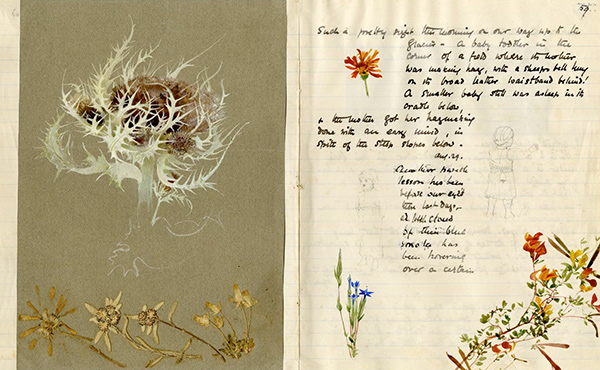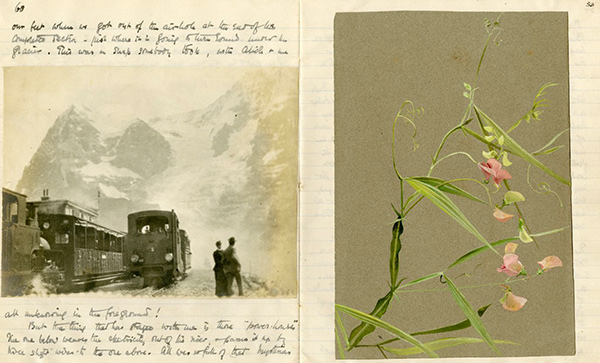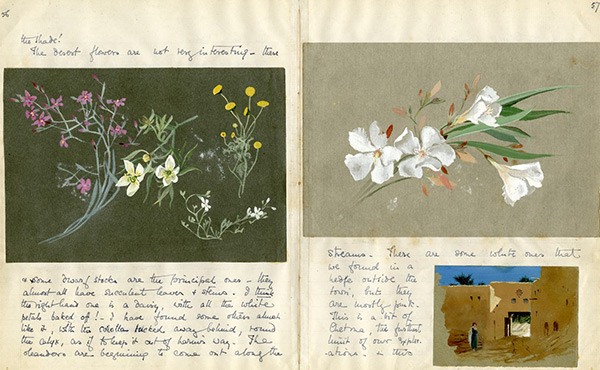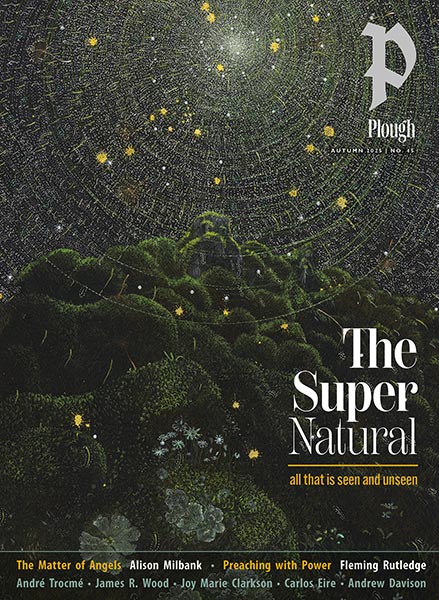Subtotal: $
Checkout
The vocation of the artist requires struggle. Whether of the financial, relational, aspirational, or spiritual kind, struggle is a key theme in the lives of artists both famous and obscure – as the journals and biographies of artist and missionary Lilias Trotter attest. Although she caught the attention and admiration of John Ruskin, an influential art critic and prominent voice in Victorian England, Trotter has remained in artistic obscurity for almost a century. Only recently has Trotter received growing attention, first through admirer and biographer Miriam Rockness, and then others who have been inspired by Trotter’s life.
At the focus of this admiration is her spiritual struggle over a decision she faced when Ruskin offered her the opportunity to become “immortal” through her art. Convinced of her skill and keen artistic eye, Ruskin was confident that under his instruction and with his influence Trotter would become a great artist. Instead, Trotter decided turn away from professional art to pursue ministry, first to London’s poor, and later to Muslims in Algeria. To this choice, most of her admirers react with applause and triumph: they understand it to be a deep sacrifice that epitomizes giving up everything to commit oneself to Christ.
Yet, as much as I also admire Trotter, I can’t help but wince when I think of her decision. I wonder about that choice – art or ministry – and about the culture and perspective that sees full-time ministry as most important and that, even when recognizing the agony of Trotter’s choice, sees it as uncomplicated. I’m not alone: on his Makers and Mystics podcast, Stephen Roach, founder of the Breath and Clay creative arts movement, admits that her story gives him a knot in his stomach. Given the fraught relationship between the church and the arts, both presently and in the recent past, this unease is understandable. Artists rightfully fight against the idea that time spent cultivating the artistic gift is a threat to, or distraction from, the work of the church.
I wonder, can these two be reconciled – this admiration and unease? Can Trotter’s story offer anything to the artist?

All illustrations are from Lilias Trotter’s journals (late 19th century)
Lilias first captured the attention of John Ruskin in 1876. Astonished at her raw talent, he eagerly took her under his tutelage. He delighted in her quickness to learn and nicknamed her “Saint Lilias.” “I pause to think how – anyhow – I can convince you of the marvelous gift that is in you,” he wrote to her. “The not seeing or feeling the power in yourself is the most sure and precious sign of it; and that tractability is another. All second-rate people, however strong, are self-conscious and obstinate.” Her talent helped to shift his dismissive views about women and painting. Even as she responded favorably to his instruction, Ruskin became concerned with what he saw to be a threat to her gift: her ministry to the poor of London, particularly prostitutes.
With concern over her devotion to him as well as to the negative effect he thought her ministry was having on her artistic skill, he sought to make her an offer she could not refuse. Bringing her to his home in Brantwood in May 1879, he laid before her an extraordinary invitation: devote herself fully to art, and “she would be the greatest living painter and do things that would be immortal.”
Instead of securing her as his student, Ruskin’s offer created a crisis of decision for her. Trotter did not desire fame. As she would write later, taking a lesson from nature, the plants “teach us absolute indifference as to whether our service is appreciated or even recognized, so long as the work is done and the Lord is glorified. The plant itself asks nothing to keep, nothing to show, nothing to glory from its whole life toil.” She viewed her commitment to Christ as nothing less than a denial of self, and her writings are filled with calls to an emptying of the self that gives everything over to God, holding nothing back.
Blanche Pigott, Trotter’s friend and biographer, writes that Trotter’s purpose was to seek “to know and follow her Lord’s will, using to the utmost what gifts he had given her. The question before her was, should she give herself to the development of her artistic gifts, to which Mr. Ruskin promised such a future, or should she continue to devote herself to direct work for souls?” She did not make the decision lightly, because for her art was not simply a skill but a source of delight. “The intense delight she felt – not at the thought of fame but at the prospect of a life given to art and surrounded by art – only made her seek all the more earnestly to be guided by God’s will alone.”
These two choices before her – developing her gifts or working for souls – raise questions about the nature of our baptism and gifting. What claims are made on us by our baptism, by our inclusion into the people of God and thus the mission of God? Likewise, what claims are made on us by the gifts that God gives, including artistic talent?
In the end, Trotter rejected Ruskin’s offer. She wrote in a letter to Pigott, “I see as clear as daylight now, I cannot give myself to painting in the way he means and continue still to ‘seek first the kingdom of God and his righteousness.’” This rejection, Trotter wrote, left her with a “grand independence of the soul.” While initially in “an almost constant state of suffocation half intoxication” by Ruskin’s offer, Trotter was certain that she could not hold both an art career and ministry together. Thus convinced, she set her sights on what she considered to be the higher calling: “A path lies within our reach making the ordinary Christian life look cold and colorless by contrast, a path leading even beyond that of consecration in its lower sense.”
I want to argue with her here. I want to cry out that God only gives good gifts, that the gift of painting is not antithetical to ministry. I want to remind her, anachronistically, of Eric Liddell’s own declaration, that God made him fast, and he felt God’s pleasure when he ran. And yet Liddell too turned his back on his running career.
“The plants teach us absolute indifference as to whether our service is appreciated or even recognized, so long as the work is done and the Lord is glorified. The plant itself asks nothing to keep, nothing to show, nothing to glory from its whole life toil.”
From a certain perspective, Trotter’s decision to give up a future as a celebrated artist in order to go to the mission field, although agonizing, is not complicated. In a narrative of the Christian life that places the highest importance on the saving of souls, every other vocation and calling becomes naturally subservient to that goal – the sole focus of a Christian’s life. In the International Bulletin of Mission Research, Lisa M. Sinclair argues that Trotter’s “very uniqueness would threaten her missionary vision.” From this perspective, the work of “culture care” (a phrase coined by the Christian artist Makoto Fujimura) must always be secondary to evangelism, and the artistic impulse becomes a distraction, even a threat, from the pressing work that must be done.
What is the nature of the artistic gift? How does it relate to the call of Jesus to carry the good news to the ends of the earth? When various gifts have been given, will there always be a tension between them, a pull and yield that sees them at opposite ends of the rope, rather than as partners? In a life of whole-hearted devotion to God, when must they part ways?

I found Lilias Trotter in the time between when my husband and I decided to move overseas and the actual moving. As a preteen, I had devoured missionary biographies, particularly of women. The stories of Mary Slessor, Amy Carmichael, Mother Teresa, Gladys Aylward, and Elisabeth Elliot filled my imagination and impressed me with a longing for sacrifice, adventure, and absolute devotion to my Savior. I did not want a mediocre, ordinary life: I wanted a life of radical obedience.
That desire waned as I grew into adulthood. Most of the longings of my preteen years had been replaced – instead of sacrifice and adventure, I desired belonging and comfort. When my husband and I heard a call for lay workers for a church revitalization in Melbourne, Australia, the missionaries I had admired felt distant, their stories weakened. When I discovered Trotter, the singularity of her desire reminded me of what it felt like to long for a life wholeheartedly devoted to God.
In Trotter’s journals I found a kindred spirit, a woman whom I could count on to be a sure guide in the cross-cultural life I would soon begin. She was one of the millions of women who left home for the mission field during the late nineteenth and early twentieth centuries. Like the more famous Amy Carmichael, as a young woman Trotter was influenced by Keswick Convention speakers, which cultivated her desire for a “higher” Christian life: one of uncompromising commitment to Christ, a life poured out through active service to the needy and unreached.
Modern missionaries admire Trotter for her pioneering methods. She modeled incarnational ministry and contextualization of the gospel long before those methods were popular. Where much missionary literature of the time focused on the points of difficulty between Islam and Christianity, Trotter’s writing demonstrates intimate knowledge of Muslim ways of thinking that focuses on likeness, not difference. Her work among the Sufi mystics in particular demonstrates a deep desire to understand the culture of those she was serving, and to present the gospel as an answer to the longings of that culture.
Trotter’s writings are earnest and passionate. Paired with her sketches and watercolors, their beauty grips me. Her insistence that the life of a Christian is cross-shaped, yet full of joy and delight in the Savior, reminded me of the women I had once longed to emulate, and I strengthened myself on her words. Yes, I said, how right she was to declare life “uncomplicated” when one submits to the Savior.
“That art that matters to us – which moves the heart, or revives the soul, or delights the senses, or offers courage for living, however we choose to describe the experience – that work is received by us as a gift is received.”
But my life soon grew complicated. What is recorded by Trotter’s biographers as a triumph of obedience and dedication to God has become a question mark – and not an entirely impersonal one. We left home for ministry’s sake, and in that context my own impulse to write sprang up, creating an internal struggle. How can I devote myself to ministry and also seek to hone the craft of writing?
Writing is not the only thing that often feels in tension with ministry. So many aspects of everyday life are called into question against the missional imperative to proclaim the gospel. This tension threatens my desire for simplicity, for a life not bifurcated by conflicting desires, not diminished by failure on the one hand to lay down my very self on the altar, or on the other, to faithfully steward the talents that have been entrusted to me.

In Exodus, Moses commissions Bezalel and Oholiab, two artisans who are particularly gifted, to accomplish the work of decorating the tabernacle. Moses tells the people that the Lord has filled Bezalel “with divine spirit, with skill, intelligence, and knowledge in every kind of craft, to devise artistic designs, to work in gold, silver, and bronze, in cutting stones for setting, and in carving wood, in every kind of craft. And he has inspired him to teach, both him and Oholiab son of Ahisamach, of the tribe of Dan” (Exod. 35:31–34). Such a testimony of God’s hand in artistic gifts makes sense of the language many artists use when speaking of their own work of creating. Identifying “inspiration” as a key part of their work, they claim that while hard work and attention to their craft are essential, there is a spark, an illumination, that happens apart from their own efforts, such that they sense themselves to be instruments more than the ones using the instruments. The Spirit blows where the Spirit chooses, uncontrollable and unbiddable.
The artistic vocation also calls into question the understanding of the mission of God to be simply “soul saving.” For one, there is more to the human soul than a simple acceptance or rejection of Jesus as one’s Savior; for another, there is more to the human experience than the afterlife. Understood rightly, the work of the artist is a ministry, a gift not only of skill from God, but, when cultivated, also a gift of beauty to others. Lewis Hyde identifies this in his 2007 book The Gift, arguing that when we speak of art as a gift “we should extend this way of speaking to its outer life as well, to the work after it has left its maker’s hands. That art that matters to us – which moves the heart, or revives the soul, or delights the senses, or offers courage for living, however we choose to describe the experience – that work is received by us as a gift is received. . . . We feel fortunate, even redeemed.” Indeed, he goes so far as to say, “Where there is no gift there is no art.”
To speak, then, of an artistic talent as a hindrance to ministry does not make sense of this experience, or of the testimony of scripture. God does not give randomly, but purposefully, and he gives gifts not for the fame of the one gifted, but for the flourishing of his world. Art, then, can be part of ministry, a rich gift offered to another for succor and delight. Offered to God, as well, “a doxology,” as Francis Schaeffer described art’s potential.
Portraying Trotter’s choice as one between art and ministry is not the only interpretation of her rejection of Ruskin. Laura Waters Hinson, director and writer of the 2016 documentary of Trotter’s life, Many Beautiful Things, sees Trotter’s struggle not “between art and ministry, but between fame and obscurity.” Hinson argues, “She knew she could do both art and mission work, but not if she wanted to become a famous painter.”
Ruskin’s offer of immortality turns Trotter away, even as she delights in art. Miriam Rockness, author of two books about Lilias Trotter and a website to commemorate her work, writes, “With his talent as a teacher and his power as cultural leader, Ruskin could launch her career single-handedly. But the offer came with a caveat. To become ‘immortal’ she would have to ‘give herself up to art.’” This language of giving over, of devoting oneself single-mindedly – this is the language of religious devotion. For Trotter, there could be only one calling so totalizing. She knew that she could not give herself over to art as Ruskin described it.
Although Ruskin asserted the necessity of works of mercy and justice, his own complicated relationship to evangelical Christianity and the church prevented him from offering Trotter a model for pursuing both art and ministry. Perhaps she also recognized the force of obsession he brought to his work and to his disciples. Regardless, his invitation to her, an artistic call to “leave all and follow,” juxtaposed itself against, rather than subordinating itself to, the call of Christ.

Many nineteenth century artists, such as Pierre-Auguste Renoir, John Singer Sargent, and Eugène Delacroix, took advantage of the French colonization of Algeria. With the ease of steamship travel across the Mediterranean and the safety guaranteed by the occupying French soldiers, Westerners could venture into Algeria with confidence, propelled by curiosity and the attraction of new subjects for their art.
Trotter’s own ability to travel to and live in Algeria cannot be neatly detached from the French colonialist project, even if her British allegiance distanced her from it. Not coincidentally does the age of imperialism coincide with the age of modern missions, as the protection of Western nations made it easier for missionaries to advance into unreached places, and the missions movement fed imperialist rhetoric about the justice of colonial efforts. Yet unlike the many painters and tourists for whom North Africa made an exotic painting destination, Trotter understood her journey to Algeria in terms reminiscent of the apostle Paul’s call to Macedonia. Pigott writes, “Whenever she prayed, the words ‘North Africa’ sounded in her soul as though a voice were calling her.”
And yet Trotter’s work in Algeria was not confined to ministry. She painted and sketched as well, with an attentiveness to the natural world that mirrored her attentiveness to the people she met. She writes, “Guides can take you to a caricature of [the city’s] setting – it needs love and trust to give entrance to the normal life of the homes.” This “entrance” she had gained through her genuine love for the people there, particularly the women.
“So we ask you to come and look at it. The color pages and the letterpress are with one and the same intent – to make you see. Many things begin with seeing in this world of ours.”
She exercised her artistic gifts among the Algerian landscapes and the people of the desert. She also used it as a tool of ministry, creating illuminated cards bearing scripture verses, decorated leaflets, and booklets of story parables that used Arabic script and illustrations of the local people. In this she imitated the apostle Paul’s example of “becoming all things to all people” in her art, creating work that appealed to the aesthetics of those she was working to reach.
So while Trotter rejected the vocation of the artist as Ruskin offered it, a rejection that pained her frequently when she lifted brush to paper, she did not reject art altogether. In addition to the ministry tools she created, she filled her journals with sketches and paintings, demonstrating her keenness of sight – a “heartsight as deep as eyesight,” in the words of Ruskin for his hero J. M. W. Turner. As evidenced by Between the Desert and the Sea, her love letter to Algeria, she continued to see and understand her world through her pencil and paintbrush. As a result, she left behind a body of work that exudes loving attention and humility towards her subjects, both the landscape and the people of Algeria.
I long for a simple ending here, a neat interpretation that allows me to reckon with Trotter’s story and take that understanding easily into my own life. But – should I be surprised? – life and vocation are not usually simple, but a complex weave of circumstances, convictions, and choices. Trotter, living at a different time and a different place, and being a different person, cannot be expected to have her life mapped onto mine.
As Trotter’s story continues to be shared, perhaps we would do well to refuse to portray her choice as uncomplicated, and art as a distraction from ministry. The world needs evangelists and artists, and the church ought to be careful not to disparage artists when they seem to be preoccupied with something it cannot see the value of. In the foreword to her book Between the Desert and the Sea, Trotter writes simply, “So we ask you to come and look at it. The color pages and the letterpress are with one and the same intent – to make you see. Many things begin with seeing in this world of ours.”
And for the artist? Trotter’s story offers a critical reminder: one’s gifts are not ultimate, and they must be worked out within the mission of God in the world. Whatever this looks like – indeed, we are right to insist that there is no one-size-fits-all template – the artistic gift is enhanced, not diminished, by the practical love of another.
Originally from Western Pennsylvania, Laura Cerbus lives and teaches in Melbourne, Australia, where she is becoming acquainted with the beauty and grief of cross-cultural life. Along with her husband and three children, she worships and serves in a local church revitalization. She writes at lauracerbus.com.
Already a subscriber? Sign in
Try 3 months of unlimited access. Start your FREE TRIAL today. Cancel anytime.






Mary
Thank you for this!! It is often on my mind, the tug between art and its role in my working out my salvation and witnessing to others, on my worst days I think it is a waste of time/ a guilty pleasure. This helped put into proper perspective.